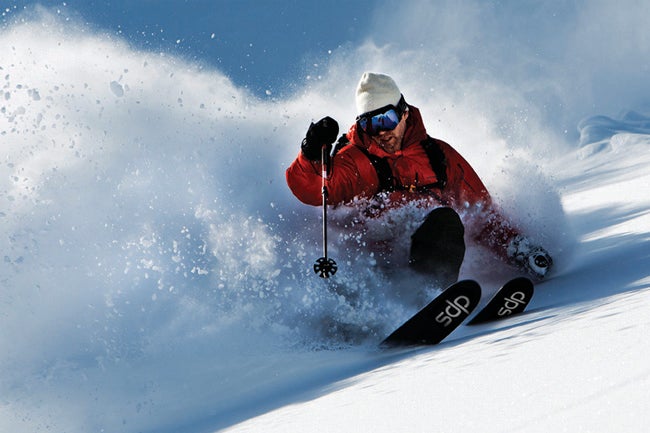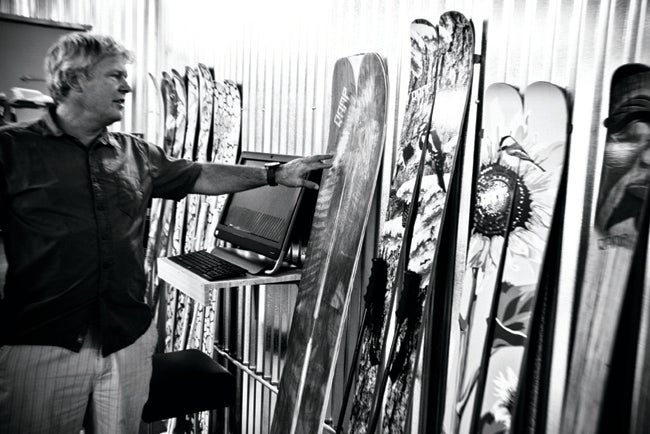Heading out the door? Read this article on the new Outside+ app available now on iOS devices for members! Download the app.

It’s a sunny August day and tens of thousands of fans stream into Washington’s Gorge Amphitheatre for the first of three packed Dave Matthews Band shows. Many are surprised to find a booth displaying skis from an unfamiliar company called RAMP. “Whoa, skis,” one faded fellow in a tank top says. Another points to the steep, grassy amphitheater slope: “Mind if I borrow these for a quick run?” Almost every visitor to the booth grabs a ski and flexes it.
Before that day, three things about that scene would have surprised me. In order of surprisingness: (1) The Dave Matthews Band still exists? (2) People still pay money to see the Dave Matthews Band? (3) A ski company is hitching its brand to the Dave Matthews Band?*
The least surprised guy here is Mike Kilchenstein, owner of RAMP sports and friend of the band’s manager. Kilchenstein left a 32-year Rossignol career in 2008 to launch RAMP, a Park City indie brand whose hallmark is internet sales coupled with extensive demo events. The brand has only six dealers, but in 2012 it hosted no fewer than 130 ski-area demos. The unique sales strategy makes a lot of sense for Kilchenstein, an easygoing extrovert. In three days he never tires of talking to people, no matter how drunk, sunburned, or tedious they are. (“Dude, are these water skis?”)
RAMP’s marketing strategy might be unique, but as a startup ski maker, it is hardly alone. Over the past decade, the number of manufacturers has exploded. New brands, armed with inexpensive computer design software and easy access to potential customers through the internet, have popped up across North America and Europe. Much of the manufacturing has been done in Asian factories, but many brands have kept it USA-made from the start, using small domestic facilities and, yes, a garage or two. A handful of familiar brands still control about 90 percent of the $533 million American market, but Exoticskis.com, which catalogs smaller ski companies, lists an incredible 300 ski brands currently in business. “It’s a lot like the microbrewing boom,” says Exoticskis’ Eric Edelstein. “Certain consumers like the cachet of unique, local brands. Or they like being able to call up the guy who is laying up their skis.”
As with the beer boom, the apparent success of new brands has emboldened other entrepreneurs to try their hand. Edelstein says he typically adds six or seven new companies to his list each year, while a few others fall off. His taxonomy isn’t particularly scientific—anyone who isn’t the “big 10 or 12 companies” makes the

(photo by Ryan Dionne)
Exoticskis list, he says. (Line Skis remains on it despite its 2006 sale to K2.) About 174 of the 300 manufacturers are based in Europe and have little impact on the American market. But the remaining brands run from “guys in their garage with a ski press” to companies like Tahoe’s Praxis, which makes its own skis as well as those of other brands (like Dean Cummings’s new H2O Gear), and brands like DPS, which makes most of its product in China.
What they all have in common is the internet, says data analyst Kelly Davis of Snow Sports Industries America (SIA). “Webpages and social media give small companies equal space in front of the consumer.”
That’s what RAMP’s Kilchenstein is banking on. “In the old days, the number of sales you got correlated directly to how much wall space you had in ski shops,” he says. “The only way to grow was to take wall space from another company. With the internet, our site can get just as many eyeballs as Rossignol’s.” Then, without dealer costs, he says, he can sell skis for about 15 percent less than comparable models sold in shops.
One market segment he is particularly focused on is women. RAMP’s best seller is its 90-millimeter-waisted Chickadee, and overall sales of women’s skis tripled in 2012. Things are going well enough that the company has moved its manufacturing from Taiwan to a new factory in Park City. Since June, design and manufacturing have been in the hands of an experienced engineer hired away from a European factory.
Is online retailing the inevitable future of ski sales? Not according to Philip Drake, marketing director at DPS, which makes carbon-fiber skis in innovative shapes. DPS sold exclusively online for its first four years. But its growth exploded when it started selling through ski shops—125 to 150 percent each of the past three years. Dealers—130 worldwide—are now an important part of DPS’s sales strategy. “You reach a point when you can only grow so much if you are direct,” Drake says.
Driven by a passion to get his skis in front of the public, no matter the venue—even a Dave Matthews concert in August—RAMP’s Kilchenstein might be the exception. “SIA estimates that about 20 percent of skis are now sold online,” he says. “Twenty-five percent of people will only ever buy skis in a shop. But that leaves the middle 55 percent up for grabs.”